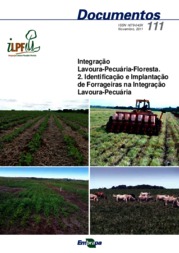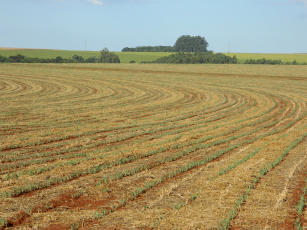Integração lavoura-pecuária-floresta. 2. Identificação e implantação de forrageiras na integração lavoura-pecuária.
Integração lavoura-pecuária-floresta. 2. Identificação e implantação de forrageiras na integração lavoura-pecuária.
Author(s): MACHADO, L. A. Z.; CECCON, G.; ADEGAS, F. S.
Summary: RESUMO: Nos sistemas de integração Lavoura-Pecuária (iLP) existem arranjos e métodos de formação de pastagens que permitem aumentar a produção animal e alterar o ambiente, tornando-o mais favorável à produção de grãos. O cultivo de forrageiras solteiras ou em consórcio com culturas tem crescido, mas este assunto é novo para muitos técnicos e agricultores que têm dificuldade na identificação das espécies e cultivares de forrageiras. Com isso, eles têm dificuldade em implantar as pastagens e estabelecer seu manejo. Existem algumas características morfológicas, relacionadas à folha, à presença de cera e pelos e ao tipo de inflorescência, que permitem a identificação das cultivares de forrageira no campo, com facilidade. Entre as forrageiras disponíveis no mercado existem algumas como milheto, sorgo, Panicum maximum e Brachiaria spp., que apresentam características mais favoráveis ao cultivo em sistemas de iLP. Algumas forrageiras estabelecem com facilidade e são mais produtivas durante a estação seca e, ainda, são controladas com menor dose de herbicida e morrem com maior rapidez. Assim, é necessário menos tempo entre a dessecação e o estabelecimento de uma nova cultura em sucessão. Crop-Livestock-Forest Integration System. 2. Identifying and Establishing Forages in Integrated Crop-Livestock. ABSTRACT: There are arrangements and methods to establishing pasture in croplivestock integration systems (CLI) that may increase animal production and change cropping environment, making it more favorable to grain production. Cultivation of forages, either alone or mixed with other crops, has been improved, but this is a new subject to many farmers and technicians who have difficulty in identifying forage species and cultivars. Therefore, it is hard to assess forage establishment and appropriate management. There are some morphological characteristics related to leaves, to waxy and pubescence and to type of inflorescence which make easy to identify different cultivars in the field. Pearl millet, sorghum, Panicum maximum and Brachiaria spp. are some commercial forages which are suitable to CLI systems. Some forages are easily established and are more productive during dry season; additionally, they are burned down with a lower dose of herbicide and die more quickly. So, the time between the desiccation and the establishment of a new crop in succession is shorter.
Publication year: 2011
Types of publication: Books
Observation
Some of Embrapa's publications are published as ePub files. To read them, use or download one of the following free software options to your computer or mobile device. Android: Google Play Books; IOS: iBooks; Windows and Linux: Calibre.
Access other publications
Access the Agricultural Research Database (BDPA) to consult Embrapa's full library collection and records.
Visit Embrapa Bookstore to purchase books and other publications sold by Embrapa.


